We may receive a commission when you use our affiliate links. However, this does not impact our recommendations.
If you ever write a book on workbenches or tool chests, be prepared for this question: “Off the record and just between you and me, what’s your favorite chest or bench?”
The easy way out would be to give them a direct answer: a Dutch Roubo Nicholson with Japanese planing stops and Krenov-style tills. But that answer would be a lie.
Many of the strong opinions and hard-and-fast rules in our craft are formed out of intellectual laziness, in my opinion. Yes, your bench works, but have you examined why it works? Have you considered that those core attributes might be present on other benches that you dislike?
I’ve written a lot about the core ideas behind good workbench design (check out “Workbenches: From Design & Theory to Construction and Use” or “The Workbench Design Book”). But I haven’t written much about the core principles of tool storage – chests, cabinets totes and racks.
As a devoted user of hand tools, I have strong ideas about what’s important. But I don’t give a squirrel’s kiester how you put those ideas into practice. I use an English floor chest and a small rack above my bench. But these ideas can be transferred on to almost any form (except for the tool pillowcase).
Before I lay these out, I ask that you be intellectually honest with yourself when you evaluate the way you store your tools. It’s easy to think you’re doing a fine job when things could be improved if you just look around at what others have done.
1. Everything in reach. Ever had surgery? There’s a reason that surgeons don’t roll into an operating room with a Kennedy box filled with scalpels, speculums and sponges. If you want to work efficiently, you should have all your tools under your eyeballs.
After working in lots of shops with a wide variety of arrangements, I have concluded that an optimal and realistic set-up is to have every tool – at most – one hand motion away from your eyeballs. Most of your tool set should be visible at all times. But the lesser-used tools can be one hand-motion away: Move a till to see a tool below.
Where it gets silly is where you open a door, pull out a drawer and slide an internal till to reach your nailset, which is actually in the drawer above…. If you have to think: In what drawer are my trammels? You have too many drawers or a memory that isn’t sharp enough for that approach.
For me, I have concluded that a floor chest is as close to the surgeon’s set-up as is possible. Other approaches that work equally well: Wall racks or open shelving that does not allow you to pile everything on top of or in front of other tools. The key word is visibility. You can’t grab it if you can’t see it.
2. Realistic protection. If you are off to repair the International Space Station, then your level of tool protection should be fairly insane. There aren’t many mil-spec tool stores in orbit. But for the rest of us, the enemy is not radiation or the vacuum of space.
It’s rust.
Where does rust come from? No, I know you aren’t stupid. It’s a real question with a surprising answer. Yes, water will grab your poor iron molecules and create iron oxide (rust). So we need to protect them against humidity and direct contact with water.
But why do tools rust so quickly in the sea air? Humidity and salt. What is shocking is that salt is a problem even if you don’t live on the coast. Salt is frequently found in the dust floating around our houses. The salt settles on your tools and grabs some water from the air to have a rust party.
So wipe down your tools with an oily rag (any oil will do) and put them in a place where the dust and humidity can’t get them – a box of some sort.
Tool chests, wall chests and Tupperware are great at stopping both humidity and dust. Racks and open shelving are not.
3. Overall dimensions accommodate common tools. When I started studying traditional tool chests, I was amused at how many of them were almost the same size: 24” high, 24” deep and 38” long. After studying traditional tool storage, I found that the length – about 35” to 38” in most cases – was the most critical dimension. Without that dimension you can’t store a common handsaw that has a 26”-long blade and a 5”-long handle.
I’ve seen a lot of tool chests that can take only panel saws – shorter saws that were more commonly used by furniture-makers. If you want to go this route, that’s cool. You can make your chest a little smaller. But the trade-off is money. Panel saws – vintage or new – are always more expensive than the ubiquitous handsaw with a 26”-long blade.
If you decide to go with panel saws, then you have another hurdle to cross. If you make your tool-holding thingy less than 24” long then you will have trouble storing a jointer plane, the longest of the traditional handplanes.
The Stanley No. 7 jointer plane is 22” long, which is the bare minimum interior dimension I would ever consider for a chest or cabinet.
When I design a tool chest or cabinet for me or a customer, I stick with 34” long as the minimum dimension. Though the customer might not be interested in handsaws now, it’s only a matter of time.
Next up: Volume and mass.
— Christopher Schwarz
Here are some supplies and tools we find essential in our everyday work around the shop. We may receive a commission from sales referred by our links; however, we have carefully selected these products for their usefulness and quality.



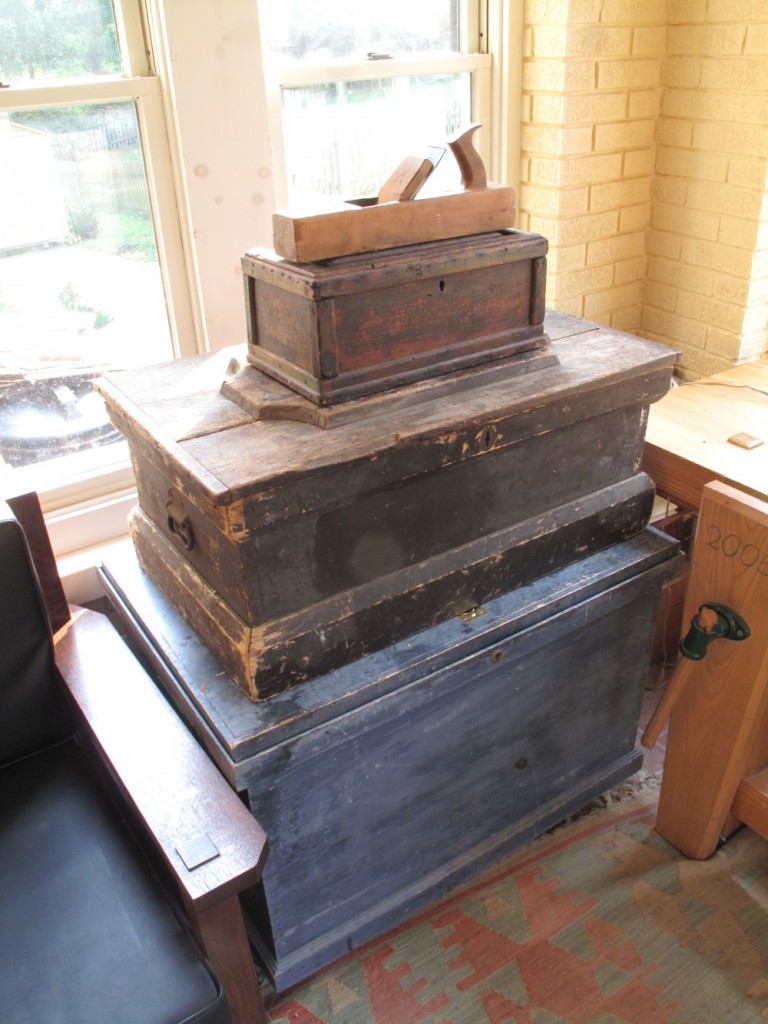
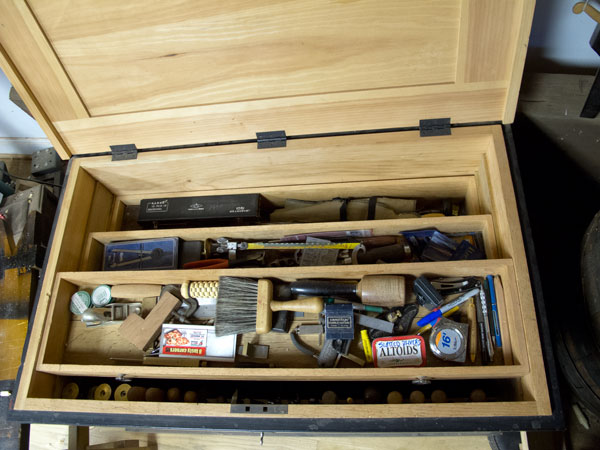
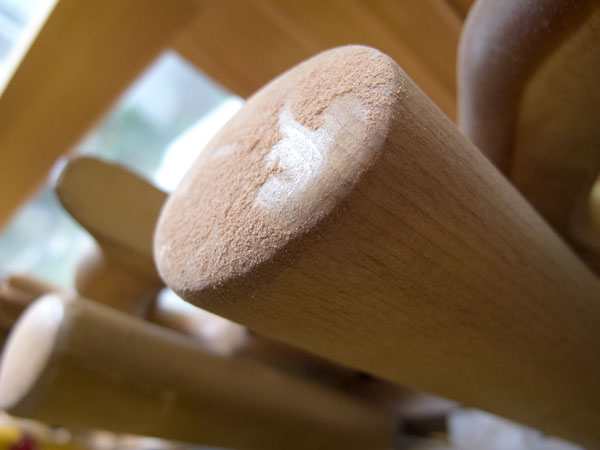
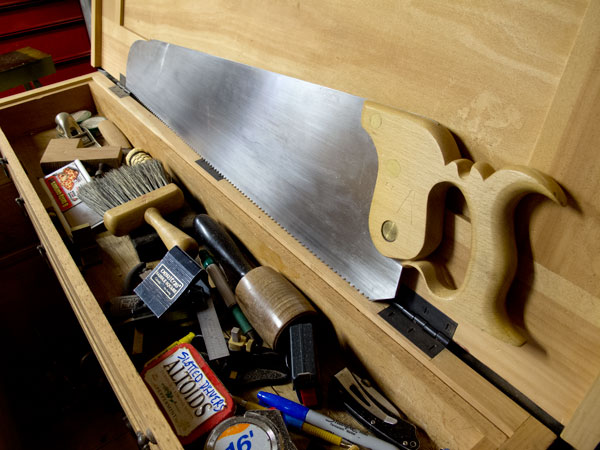




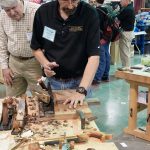
Hi Chris,
I have only recently seen your excellent work, especially the tool chests.
I was very surprised to realise that I had seen such a box (almost identical) to the one I recently had handed down to me that must be very old. i wondered if you could point me in the direction that I could look for material to research the origins of my box.
Mine is to be found on the lumberjocks forum under bigalscorpio if you would like to see it. BTW I am in the UK and I hazard a guess that you are in the USA so the chest has very wide reaching origins.
Thanks, Al
Number one “everything within reach” reminds me of something I read a while ago. Adam Savage wrote about his modelmaking tool kit and how he created a tool box where he could reach everything without having to move any other thing. He called this characteristic “first order retrievability.” A quick google search finds the article Mr Savage wrote about it for Wired Magazine. I was facinated by the common theme in two different fields of making things.
Whatever happened to those German taps & dies for wood that were under evaluation???
I keep my tools hanging on the wall. For me, it’s not just about speed and efficiency, though that is a very important part of it. I arranged my kitchen the same way, with most of the kitchen tools hanging on the wall.
First of all, I don’t notice any problems with rust created by this storage approach. Rust seems to be produced only by my sweat where I touch tools, so the block plane, the shoulder plane, and the steel straight edge show some darkening in places where I handle them, but other tools do not. This would presumably be better if I was more religious about oiling, but it wouldn’t be helped by closed storage. My shop is in a basement. I run a dehumidifier to keep the humidity down to about 55%. I’m not sure why my environment less less corrosive than Chris’s environment.
Secondly, the reason it’s important to me to have my tools out and visible is that it gives me a better chance of picking the right tool for the job. This may not be an issue for someone who is an expert and knows exactly how to do every task, but I’m not always sure: Should I use rasps? Should I use the spokeshave? Or the block plane? Seeing all of them helps me better consider my options and make sit less likely that I’ll select the last tool I used even if it’s not the best one for the task.
One last observation is that tools tend to accumulate on my benchtop. I think for me this is a greater risk to tools than rust—it’s not good to run a plane into a straight edge, chisel, or another plane. I’ve never worked out of the sort of tool boxes Chris likes, but I have had stuff in a machinist toolbox with lots of shallow drawers, and I find it’s *much* harder for me to put tools away into that toolbox as I work than it is to stick them back up on the wall. My planes used to be in a drawer in plane socks and I wouldn’t put them away until I got to the end of the project.
Chris, how do you organize your countersinks that you don’t want to hunt for in drawers? I have never seen a satisfactory storage method for drill bits and the like that works if you buy bits one by one and want to keep your collection organized so you can quickly tell what you have and if something is missing (and where something goes). It’s easy enough to work up a system for a fixed set of bits…but how can the system adapt when you buy more bits?
I use a tool rack which is mostly a series of horizontal shelves on the wall behind my workbench. I live in Brisbane, Australia (subtropical; the neighbors have a banana tree in their yard). I’ve never noticed any rust — but then, I keep everything nicely oiled.
As an additional thought: since it is dust that faciliates rust, it seems like metal tools with horizontal surfaces would be the main victims. So (for example) saws in a saw till should be relatively immune — whereas a handplane on its side would get rusty cheeks. Does that sound plausible?
As always, I enjoy your blog postings and insights. Looking forwards to the next installment of this theme.
–GG
Chris does run about a bit and I too enjoy my woodwork being somewhat more contemplative. However I have found using a small chest and a wall cabinet protects my tools from rust and the damage from banging against each other. They also stop my tools from hiding from me! Searching for a tool irritates me and I prefer to spend the time standing back and gloating. Altogether these two storage units have made my amateur woodworking much more enjoyable. The bonus is that they have given me pause to consider what tools I actually need. In turn I now realise that improving my skills yields more than buying “better” tools.
Tool chests were often made by apprentices nearing the end of their “time”. Having made one I now understand why. They present many of the challenges facing the furniture maker and for me have been an important part of my “journey(man)” from joiner to cabinetmaker.
Chris,
I have a philosophical disagreement with you emphasis on speed and efficiency. I don’t think it’s important for everybody.
As an analytical chemist, I have to be rather efficient and “Yes” very anal every day at work to provide high quality data.
At home, I don’t need to be efficient and relish the ability to take my time working on projects – a big part of my separation of work and home mantra. In fact, on many occasions, the time it takes me to get a tool is very well spent – I think about my next step or some design feature or simply “how am I going to …”.
You hit the road with your tools – I never do. Your shop time is at a premium and you have to bang out projects while mine is hobby and relaxing and with no real deadlines even when I making something for a client. And I suppose that I’ll work just as slowly in retirement too (why not? I’ll have more time!)
Your professional world is quite different from my amateur world. I’m just happy to learn some things from yours.
Thanks,
Joe